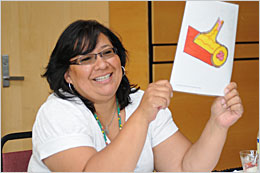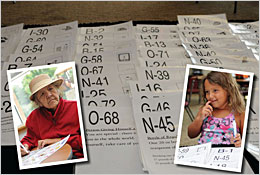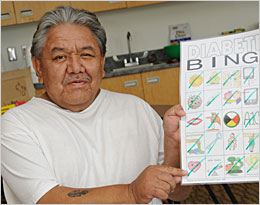Lower Sioux Tribe's Diabetes Bingo Offers a Memorable Blend of Facts and Fun

Marisa Pigeon showing an unhealthy artery during Diabetes Bingo.
The Community-Directed SDPI Program of the Lower Sioux Tribe in south central Minnesota offers many diabetes management and prevention activities. These include monthly education classes about diabetes and heart disease, women and men's health nights, exercise classes for all ages, and diabetes bingo.
The term "diabetes bingo" may sound like an oxymoron. Can diabetes, a serious word, and bingo, a fun word, be combined? "Yes," says Marisa Pigeon, RN, SDPI Program Manager.
During a typical diabetes bingo class, Marisa hands out laminated boards to each player. Across the top are the letters B.I.N.G.O. which stand for diabetes-related categories: body parts, insulin, nutrition, glucose and other. Under each letter are columns of five illustrations that match cards Marisa may select. Everyone is studying their boards of 25 illustrations such as a pill container with a clock in the background, a glucometer with a test strip about to be inserted, and a naked (skinless) chicken.
Marisa holds up a card with an illustration of an unhealthy blood vessel, then reads the back. This card is categorized under B for body parts. She says, "Under the B. Unhealthy blood vessel. It is clogged from too much fat in the blood."

Diabetes Bingo attracts elders and youth.
Participants are listening intently and concentrating on their boards. The serious information is going into their memory banks. As Marisa holds up and reads more cards, they learn more:
"Your A1C tells you and your doctor what your average blood sugar levels have been for the past 90 days."
"Don't use antibacterial soap on your feet. It dries the skin too much."
"Fat in the blood makes it harder for insulin to do its job."
It is quiet in the room as participants listen and focus on their boards. As the game progresses, they hear 17 facts on how to prevent diabetes or its complications. Then the fun part kicks in: "Bingo!" says Marilyn Hisday. Everyone claps, Marisa verifies the win, then Marilyn checks out the prize table and chooses a car wash kit.
The Lower Sioux Tribe Diabetes Program started the bingo class about two years ago. The White Earth Diabetes Project developed the game, which features illustrations aimed at Native American audiences. Marisa says it is effective because it is repetitious. She meticulously reads every word on the back of each card. Participants may hear the same information a few times during a one-hour game, then again when they attend the following month.

Lower Sioux Tribe Diabetes Bingo group.
The repetition coupled with a fun, relaxed atmosphere, helps people memorize the facts. "When I read the cards, a lot of times the participants say the information along with me," says Marisa. And when she is in her office, she often overhears clients who have attended diabetes bingo passing on information to others. "Once I heard someone say, ‘Did you know that the pop you're drinking has 20 teaspoons of sugar in it?'"
Diabetes bingo offers another venue for presenting diabetes information, one that works for many community members. Marisa sees it as a great opportunity. "Many times I intersperse additional information in the game, like facts about high blood pressure and how it affects a person's body. It isn't always the most enjoyable thing to talk about, but I find if I do it during diabetes bingo, it's a little less intense."


